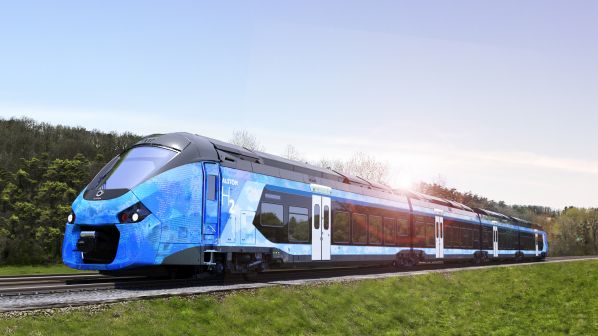SNCF says several initiatives have been put in place under its 2018 Corporate Social Responsibility Report, notably the development of electric operation thanks to agrofuels with the introduction of hybrid trains from 2020, experimentation with hydrogen train in 2022, and the elimination of diesel traction by 2035.
SNCF says it has decided to accelerate the greening of its railway equipment. Currently, 80% of SNCF trains are electric but half of the TER regional train fleet is still diesel. Today, 20% of rail trips are by diesel traction, and 40% of these trips are by TER trains.
SNCF and Alstom are testing the first hybrid TER in partnership with the Centre-Val-de-Loire, Grand Est, New Aquitaine and Occitanie regions. The train combines overhead power supply, diesel engines and energy stored in batteries.
The hybrid train provides a 20% reduction in energy consumption and pollutant emissions. It emits no pollution in urban areas as the diesel engine is shut down and the train is powered by battery using stored and recovered braking energy. To minimise the power drawn from the catenary, batteries are also used during acceleration. SNCF says this reduces the cost per kilometre by around 50%. Deployment is planned as follows:
- 2020: operation of the first Régiolis hybrid train, once the test phases have been validated
- 2021: entry of the first train in commercial service to validate performance in real conditions, and
- 2022: series deployment.
Other innovations include the use of bio-diesel produced in France from rapeseed oil and limited electrification combined with battery and hydrogen trains.
SNCF sees hydrogen trains as the way to eliminate diesel traction by 2035 as they only emit water vapor. Five regions - Occitanie, Bourgogne-Franche Comté, Auvergne Rhône-Alpes, Grand Est and New Aquitaine - have already agreed to conduct trials and could order about 15 new trains this year.
Funding of the hydrogen train project will be shared between industry, regions and the state. The cost of studies and the production of the first prototype train is estimated at €59m, with the state and the regions committing around €22m.
Solar power
SNCF committed to the expansion of solar power in July 2018 to make buildings self-sufficient in energy consumption. “The goal is to become a solar energy producer by more systematically using our stations, the roofs of our buildings and our depots,” SNCF says.
SNCF has launched an electricity self-suficiency development master plan for existing buildings, excluding stations, with a roof area of over 3000m² to determine which roofs are suitable for the installation of solar panels. “We will have made 100 hectares available to produce solar energy within five years,” SNCF says. “The first studies reveal an estimated potential of 37GWh on 210,000m² of eligible roof.”
SNCF plans to invest around €5m installing solar panels and says the Lille Hellemmes TGV depot will be 85% self-sufficient from the second half of 2019 and Romilly-sur-Seine depot will generate 100% of its electricity requirement by the end the year. A feasibility study is underway to install solar panels on the roof of Paris Saint-Lazare station. SNCF has built a 17-hectare solar power station on a former industrial wasteland in Surdon which is used to power 2960 households.
Zero waste
Since 2013, SNCF has been pursuing a policy aimed at limiting the consumption of resources, reducing waste in all its operating processes, and promoting end-of-life products. SNCF has decided to strengthen its action by setting the goal of reaching zero waste by 2035.
SNCF provides end-of-life management for rolling stock and optimises the recovery of extracted materials such as steel, copper, glass, plastics, rubber, textiles and foams, which feeds recycling channels. In order to industrialise the process, SNCF will accelerate the development of its seven existing sites in France. By 2021, eight new centres will be created with the aim of processing more than 1000 bodyshells per year, creating 360 permanent jobs.

